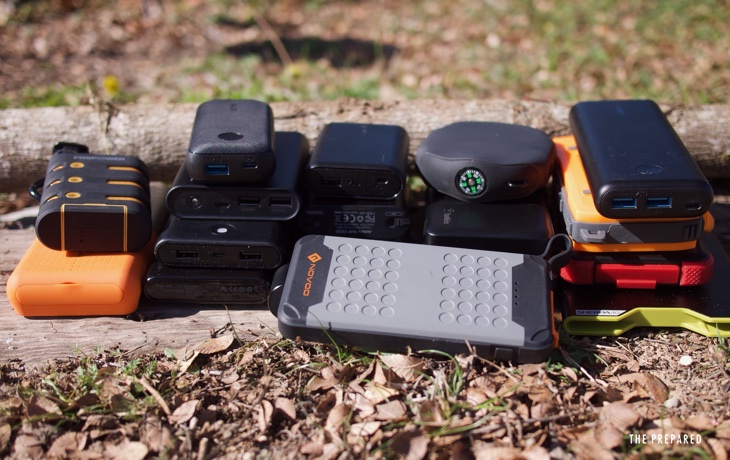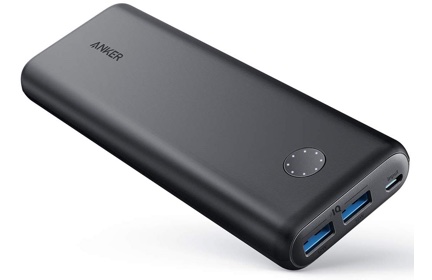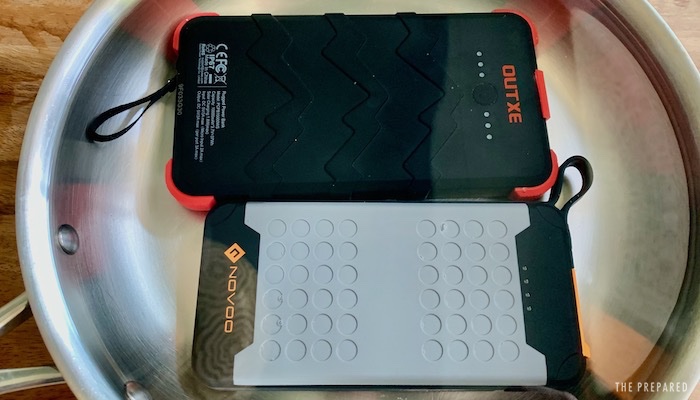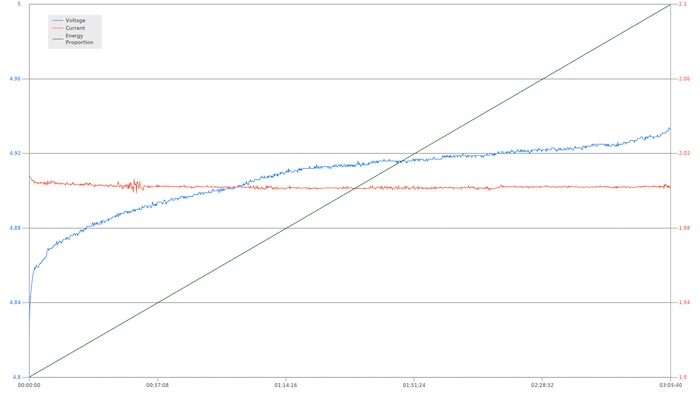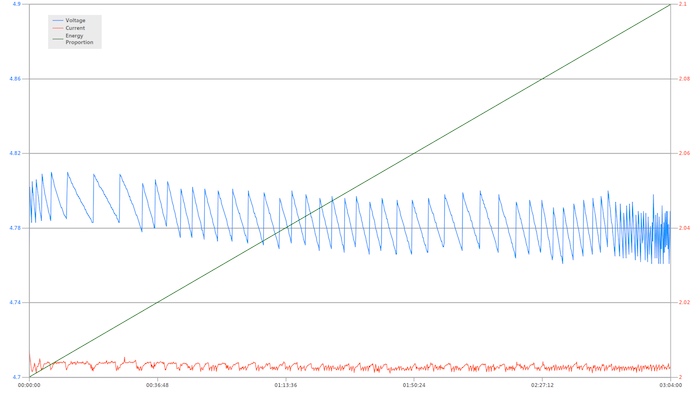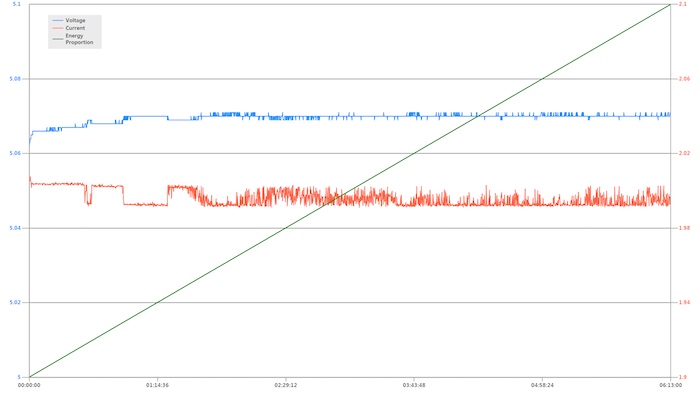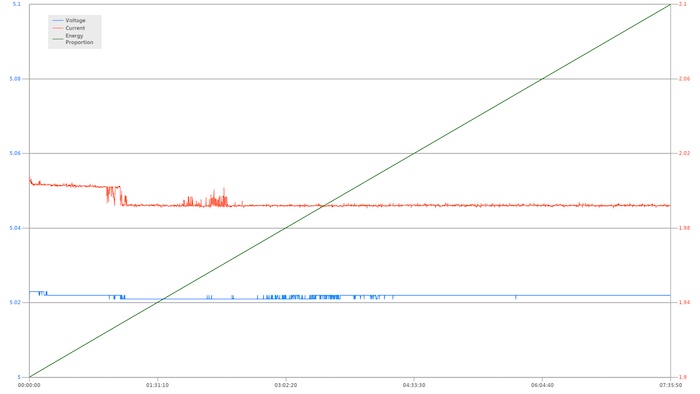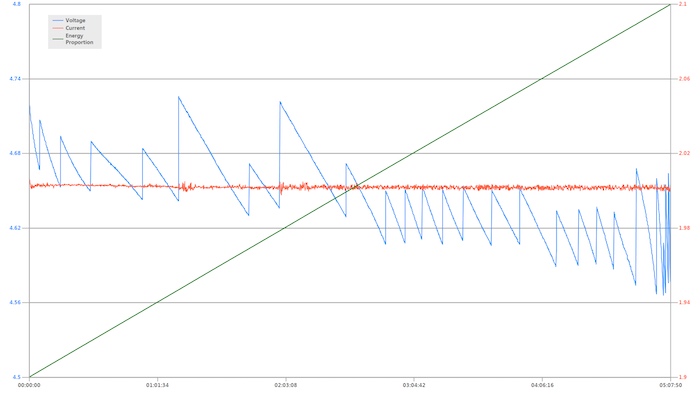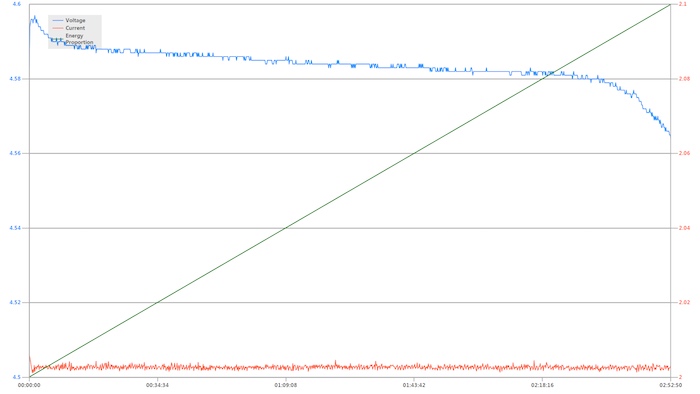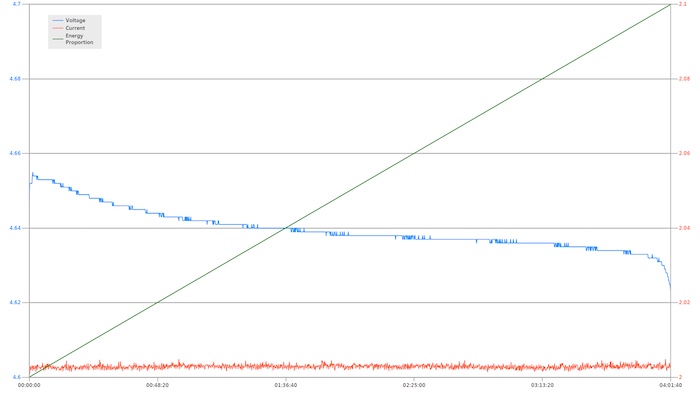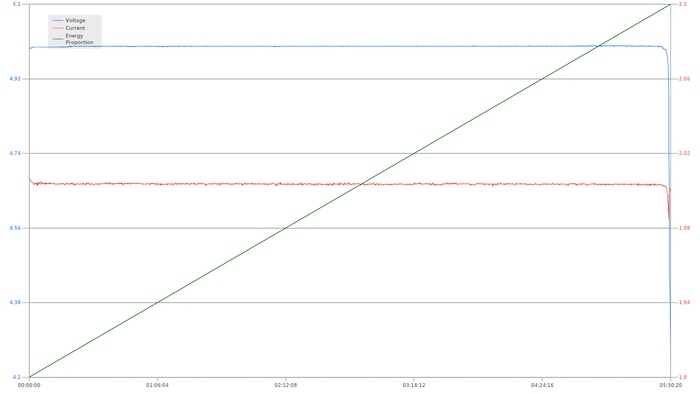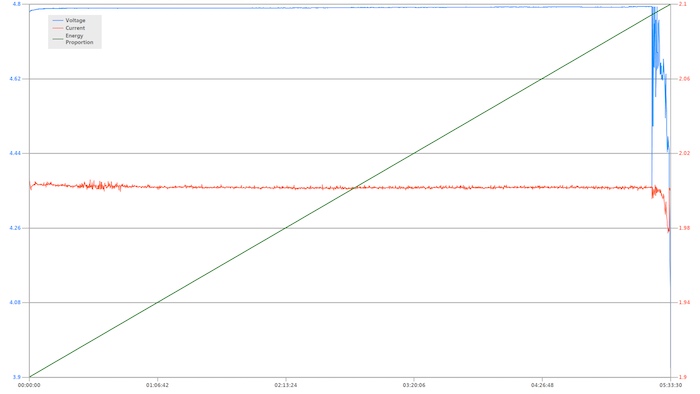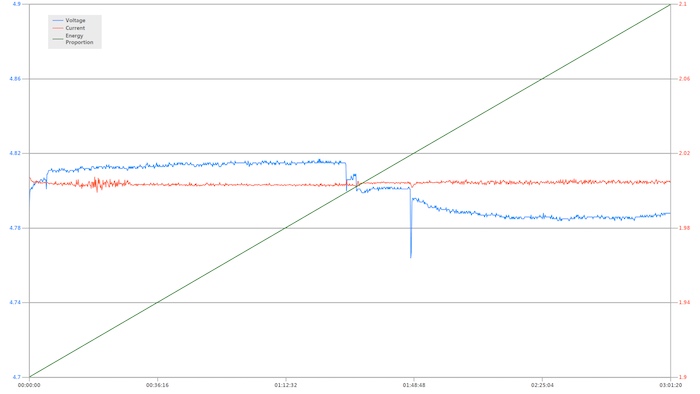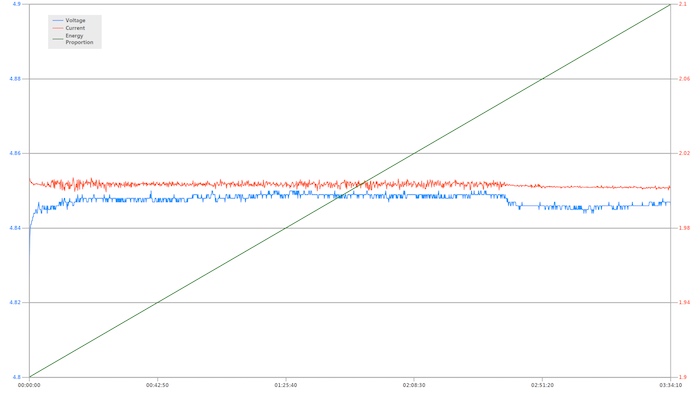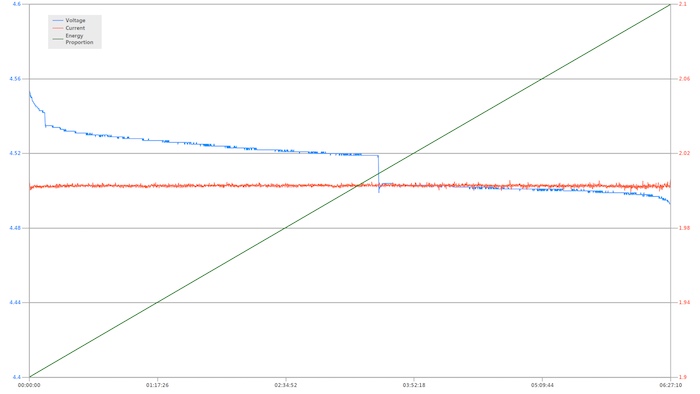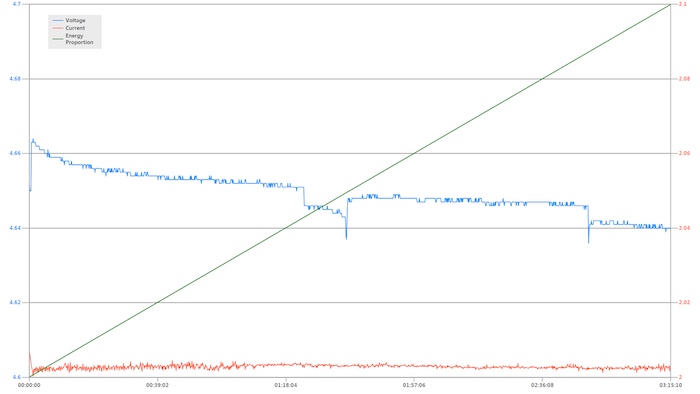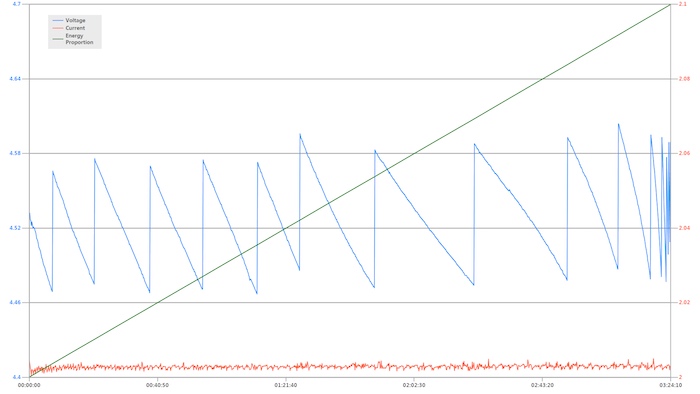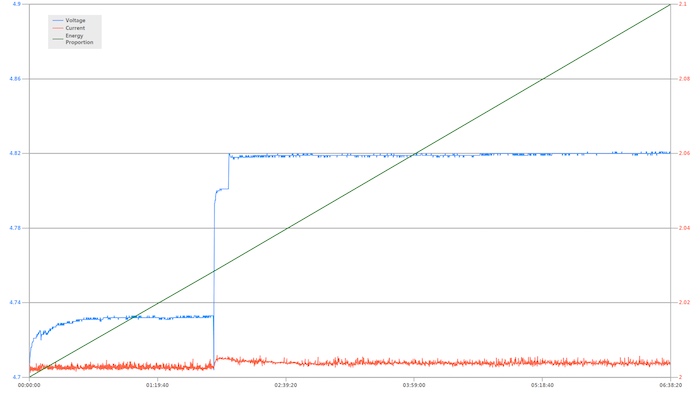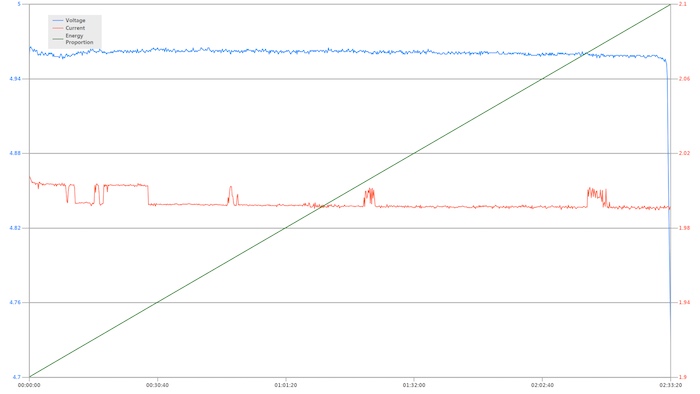Since these power packs should always be charged while waiting for an emergency, you know you’ll be able to charge a phone, headlamp, or other gear no matter what’s happening. You then recharge the power bank via a wall plug whenever you can. Or, if the grid is unavailable, these “chargers” pair perfectly with another core piece of your kit — a portable solar charger — which feeds energy into the battery.
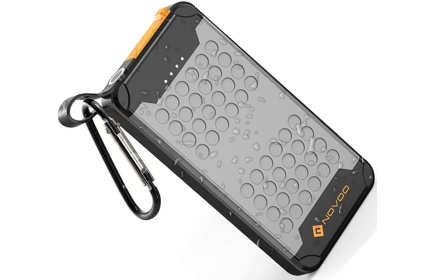
If you only get one:
NOVOO Explorer
If you only buy one thing, check out the NOVOO Explorer 10,000mAh, a top performer both on paper and in our own performance review. Although we generally think “survival” features in these kinds of products are a gimmick to avoid, such as built-in lights or compasses that are only designed to get you to click “Buy,” in this case the NOVOO won us over. It’s waterproof (which we validated in a dunk test), the LED light is legitimately useful, and the rugged design does add durability without costing much more money or weight.
More: Learn the basics of off-grid power and prepper tips for batteries.
The NOVOO is very reasonably priced, and it delivered plenty of charge in our electrical testing. The lone USB-A port is only 7.5W, but that low wattage is a good thing for prepping purposes, because you can drain the pack more slowly to squeeze more energy from it. But if you do need a fast charge, the USB-C port can do 18W charging via the power delivery (PD) protocol. One warning about NOVOO: this is an Amazon-only Chinese seller, so don’t have high expectations for support if something’s wrong with the unit (although Amazon will step up if you have a problem within the return window).
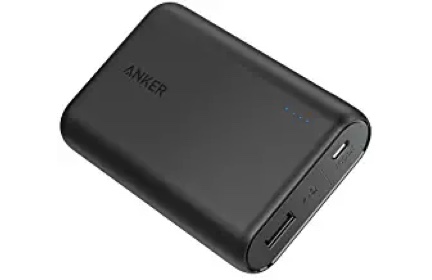
Compact pick:
Anker PowerCore 10000
If you’re looking to keep your weight budget to the absolute minimum while still carrying enough charge to refill an iPhone three or four times, then the best ultra compact bank is the Anker PowerCore 1000. This 6.35-ounce power pack is the smallest and lightest 10,000mAh charger we tested. It’s also backed by Anker’s well-established reputation for quality and support. The unit’s single USB-A dedicated output port has PowerIQ circuitry that can charge at up to 12W if you need a quicker charge. You’ll pay a premium for the Anker name and higher capacity per ounce, though, and it’s not as outdoors-friendly as the NOVOO.
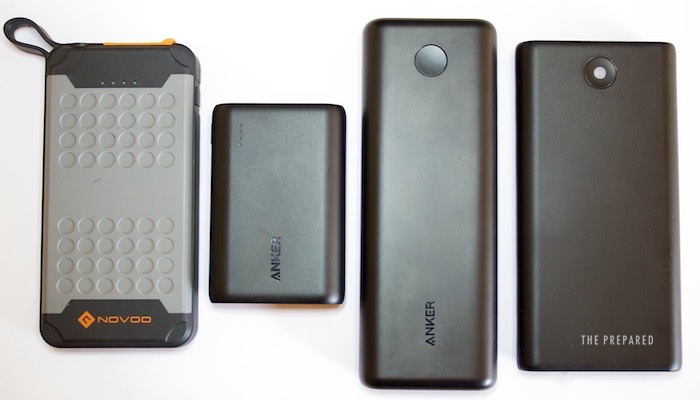
Bigger is always better with batteries, so we’d normally try to steer you toward a 20,000mAh pack if you’re someone who can afford to dedicate as much as 12oz of pack weight to a USB charger.
But in this case, unless you really need the big pack (see next pick), we’re taking the unusual step of suggesting you carry two 10,000mAh packs instead of one big pack. The way these packs are built means that two 10k packs are about the same capacity-to-weight ratio (ie. energy density), size, weight, and cost as a single 20k pack. The weight penalty is usually just 1-2 oz compared to a single pack, for example.
Combined with the benefits from having two of something instead of one, we now personally carry both the NOVOO and Anker 10,000 mAh. You also increase your safety and flexibility by carrying two different models/brands. For example, the NOVOO has a pair of slow-charging 7.5W USB-A and Micro USB ports, plus a fast-charging 18W USB-C port; while the Anker has a fast-charging 12W USB-A port. So with those two chargers and four port options, you can decide if you want to charge slowly over USB-A or Micro-USB (for more battery life), a little faster over 12W USB-A, or really fast over 18W USB-C (for less battery life). No one-pack solution in this review gives you this level of flexibility for optimizing charge speed and battery life.
For high-watt needs:
Anker PowerCore II 20000
If you’re definitely going to be doing a lot of fast charging (18W or higher), or you have a USB device with 20W or higher power needs (eg. a laptop that can charge via USB-C), then you’ll probably want to upgrade to a 20,000mAh charger to get more usable capacity than you’d get out of two rapidly drained smaller packs.
The best large-but-still-portable battery pack for most people is the Anker PowerCore II, a 20,000mAh pack that in our testing gave us over 5 watt-hours of charge per ounce of pack weight — the highest such number in this whole review. The PowerCore II’s all-metal build is sturdy, and it features two high-wattage USB-A ports: one goes up to 2.4A (12W) and the other up to 3.6A (18W). There’s a micro-USB charging port, and a button with a circular row of LEDs tells you how much charge the unit has left. It’s not waterproof, but a cheap waterproof bag or plastic container will fix that and add less than an ounce to the weight.
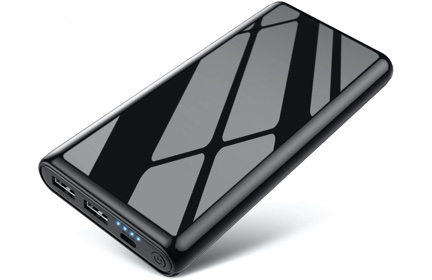
HX160Y6 20,000mAh Power Bank
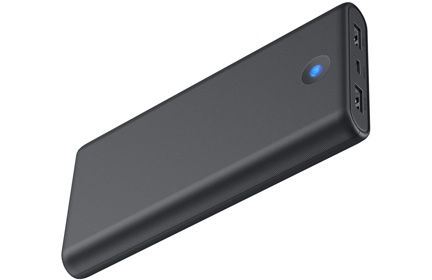
HX160Y7 20,000mAh Power Bank
If you just want the best bang-for-your-buck and don’t worry too much about weight and brand reputation, there’s a pair of Chinese 20,000mAh models widely available on Amazon under different brand names and model names that are a screaming deal. The HX160Y7 and HX160Y6 chargers are both typically advertised as 25,800mAh packs, but they’re clearly 20,000mAh packs and are very close to the Anker PowerCore II in size, weight, and overall performance — just at a meaningfully-lower price. And unlike most cheap power banks, these models performed well in our testing, with clean and stable power output.
Be prepared. Don’t be a victim.
Want more great content and giveaways? Sign up for The Prepared’s free newsletter and get the best prepping content straight to your inbox. 1-2 emails a month, 0% spam.
Why you can trust this review
As always, nothing influences our recommendations except for the merits themselves. We spent 90 total hours on this project, including field testing and researching forums and other reviews. After compiling an initial list of 27 popular products, we bought the top 16 ourselves. The primary researcher has an electrical engineering degree and has reviewed these kinds of outdoor and emergency products for years.
How we picked
To pick which products to buy for this review, and which are the winners, we first think about what things will be like in an emergency and how you’ll actually use these power banks when you need them most. That context matters, because it leads to choices that are different than for typical business travel, camping, or everyday carry needs.
Lifespan and capacity are more important than convenience. In daily life, most people use these power banks for a quick single-device top-up when they can’t find a wall plug. But in an emergency, you don’t know when you’ll get grid access again, so you’ll want to use your power bank in ways that maximize its storage capacity and long-term health.
High energy density (storage capacity per ounce of weight) that’s portable enough for a go-bag. The main constraint here is weight and size, so the goal is to get as much energy as possible within a power pack that’s still reasonable for extended foot travel.
10,000mAh to 20,000mAh is the current sweet spot of energy density and portability. 7,000mAh options, for example, currently weigh about the same as 10,000mAh options; the lightest of each are around 6oz. On the heavy end, we tried to stay under 12 ounces and had a hard limit of 16 oz / 1 pound.
Avoid fast charging (usually USB-C ports) and use USB-A ports when possible. Due to chemistry quirks, the slower you discharge a power bank, the more of its rated capacity you’ll get out of it. So to stretch the life of your battery, use the plain old vanilla USB-A at 5V/2A (or even lower amperage) whenever you can. Unless you’re really pressed for time, skip any fast charge or high-wattage ports that will drain the bank faster.
Flexibility matters. Your daily-life phone might use the modern and fast charging USB-C. So it’s fine if a daily-life power bank only has a USB-C port and you only carry a USB-C cable. But in an emergency, you want the flexibility to power multiple types of devices with common cables (including gear/cables you may find later), such as rechargeable AA/AAA batteries, headlamps, phones, tablets, and radios. Generally speaking, you have more flexibility with a USB-A port on the battery than a -C, since there are many A-to-B and A-to-C cables but C-to-whatever cables are rare (for now).
Keep it cool and avoid built-in solar. Batteries hate heat. The cooler they are, the longer they last and the more charge you get out of them. That means, for example, you’ll want to put the power bank underneath the solar charger while in the sun. Some power banks come with a small solar panel built into one side — but we think that’s nuts. You don’t really gain much value by combining the products, yet you risk cooking your battery and run the risks from having two core needs in one breakable/losable product. If we ever find such a combo pack that performs well against the plain competitors, we’ll let you know, since then you can consider the built-in solar as a nice-to-have backup in addition to a standalone panel.
Avoid unnecessary extras and “survival” gimmicks. Keep things simple and focused on the core goal of storing energy. That means you have no need for many higher-end power bank features, like the ability to act as a USB hub. If you need a USB hub, buy a separate dedicated one. Similarly, although “survival” features did impress us on some of the winners, usually the addition of a compass, whistle, etc. is worthless (and a sign of an inferior product trying to bait amateur buyers). Waterproofing, dust proofing, and designs that can handle the outdoors are great, though.
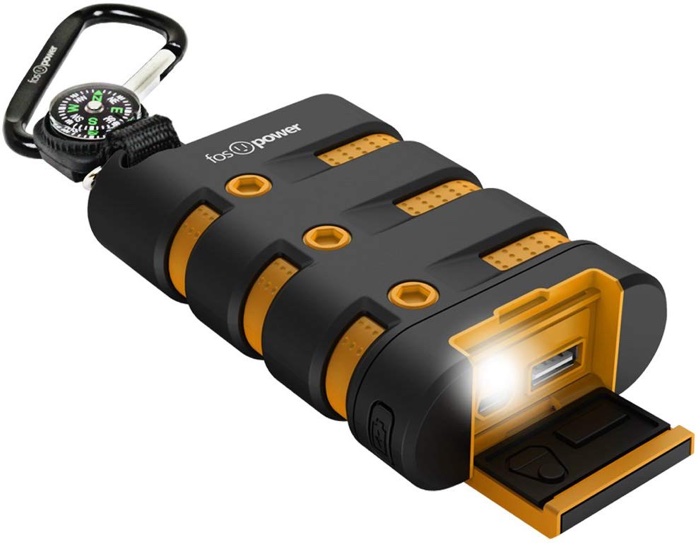
Tip: You can always put a battery bank in a durable and/or waterproof case you buy separately. This usually is just as cost- and weight-effective as if you bought a bank with those features already built in.
How we tested

We tested each battery’s capacity by fully charging it very slowly via a 5V/1A USB-A charger. We followed this 5W charging protocol, instead of a much faster charge that most of the packs support, for two reasons:
- To simulate the kind of output you’d get from a portable solar panel
- The slower you charge a Li-Ion battery, the more it stores
When each battery was fully charged, we then fully drained it by plugging it into a USB load tester set to draw a constant 2 amps. In between the load tester and the charger we placed a data-logging USB multimeter that let us record power, voltage, and total energy draw numbers.
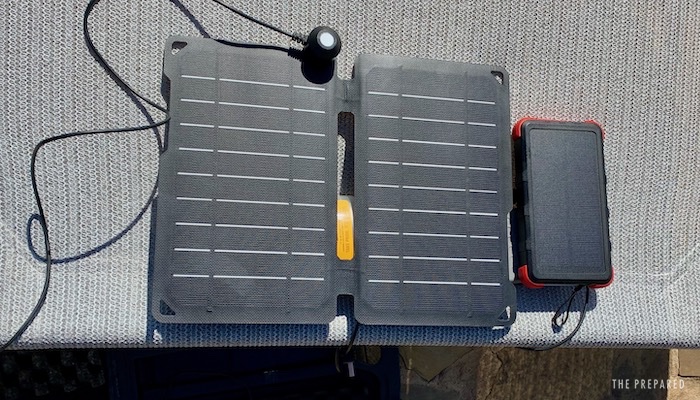
After the “lab” testing, we also paired the packs with a small Renogy 10W solar charger to measure how things worked in a real-world scenario. This happened on clear, sunny days (irradiance levels were between 575W/m2 and 750W/m2). A data logging USB multimeter captured a picture of each device’s charging session. That way, we could verify that each pack holds a stable power draw on the panel and will work in conjunction with the smallest panel we recommend.
We also plugged all of the winners into a partially charged iPhone XS Max and a Samsung Galaxy 8+, with the multimeter in the loop to monitor charging activity, just to confirm that the packs work normally with modern phones.
For the three packs in this review that are marketed as waterproof and claim an IP67 rating, we charged them and then submerged them in a few inches of water for 2 minutes. Then we dried them off and let them sit for an hour before plugging them into our testing apparatus in order to confirm they could still handle a 5V/2A test load.
Note that we did not test USB-C PD ports, or any type of quick-charging protocol support, since, again, we’re not interested in fast charging. Slower is better, and while fast charging is nice to have, it’s not a priority for this application so we didn’t invest time in testing it.
Why you should consider carrying two battery packs
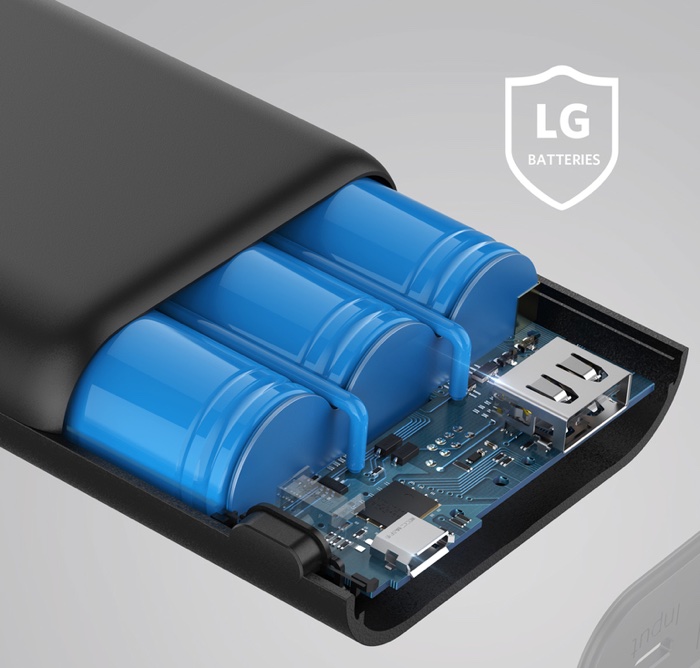
When selecting a Li-Ion power bank for emergencies, always carry the most battery capacity you can fit within your weight budget. More energy storage capacity means:
- Longer lifespan, since you’re doing fewer charge/discharge cycles for the same amount of power drawn from the device.
- More real-world capacity, because a larger bank will drain to zero more slowly (for a fixed current draw) than a smaller one, and the slower you drain your bank the more charge you get out of it.
- You can capture more charge when you get the chance, either from solar panels, a wall socket, or a larger battery.
- Better odds that you’ll have power when you need it.
Based on current 2019-2020 tech, the best approach for preppers is to carry two 10,000mAh packs, instead of giant 20,000mAh pack. The reasons are compelling:
- “Two is one, and one is none.” This core preparedness mantra speaks to the importance of having a backup of critical gear. Any kind of redundancy you can build into your preps (without sacrificing in other areas) gives you a powerful advantage in any emergency
- Nearly all the packs in this review are really repackaged collections of 18650 batteries, and since they all use basically the same battery tech and format under the hood, then carrying 20,000mAh means carrying six of these batteries. You can carry six of them in one pack, or you can carry six in two separate smaller packs, but you’re still carrying the same number 18650’s at about the same total weight and charge.
- The packs can have different port formats and features, giving you more options. You might picking pack that’s micro USB and USB-A, and another that’s USB-C and USB-A. Or, if you go with our two main picks, you’ll get one pack that’s waterproof and has a light, and another that can quick-charge some types of supported devices.
Deeper notes on testing and reading results
Skip this section if you don’t want nerd-level details.
Reading the voltage numbers
The 18650 lithium-ion batteries that make up the guts of almost all the chargers in this review operate at around 3.7V, depending on the amount of charge in them. But the USB spec is nominally 5V, though it can work with as little as 4V depending on the flavor and port type. So the Li-Ion-based chargers are running a step-up circuit in between the internal batteries and the USB port.
For a variety of reasons not worth going into here, if you’re trying to fully charge a Li-Ion battery of any type, you’ll want to be able to offer it at least 4.6V throughout the course of the charging cycle. This brings us to the fact that in many of the test runs, you can see from the graphs that the packs’ voltage output dropped to under 4.6V.
That’s ok, though, because if we dial back the 2A load to, say, 1A, the voltage on these under-volted packs rises back up to 4.6V or higher. And under normal usage conditions, any USB device you plug into the pack will figure out how much current it can draw and still get the voltage it needs to fully charge its internal battery. But load testers like the one we used aren’t that smart — our tester just presents a static, two-amp load, and doesn’t vary it even if it’s not getting good voltage.
Voltage and current fluctuations
While we like to see some stability in the voltage and current output of the pack, we didn’t put a lot of emphasis on this because we mainly just care about the overall number of watt-hours we’re getting from the unit as we discharge it.
In one or two of the packs, there are some variations in voltage that look like the pack was trying to negotiate a charging rate with the load tester, and in others there’s what could be temperature variation (batteries heat up as they charge and discharge). But we ignore these and stay focused on the final watt-hours totals.
Rated vs. measured capacities
Because we used a static load tester, we couldn’t quite wring all the capacity out of the batteries that we could have. In fact, what we’re really measuring is the amount of time you can pull a static 2A out of these packs, and not really the whole capacity. But this is a close enough proxy, and it certainly gives us a baseline for a fair comparison of all the different banks’ relative performance.
The milliamp-hour numbers that we use in the bulk of this review are based on the internal battery’s 3.7V operation, and not the USB port’s 4.5V-5V operation. When we measured the discharge capacity of these banks, we used the final watt-hours numbers and a presumed 3.7V internal battery pack to back into a real-world milliamp-hours number to compare to the rated number. So in our big spreadsheet of batteries, the watt-hours number is measured, and the milliamp-hours number is derived by dividing the watt-hours number by 3.7V.
Discharge rate vs. real-world capacity
The rate at which you drain a battery to zero is called the “C-rate”, and it’s presented as a number like 1C, 3C, 0.5C, etc. This number is the fraction of the battery’s capacity (C) you drained from it in one hour.
Example: For a hypothetical 2 amp-hour battery, if you discharge it completely in one hour (via a current draw of 2A), you’re discharging it at 1C. If you discharge it in two hours via 1A current draw, you’re discharging it at 0.5C.
The discharge rate matters for testing and usage, because the more rapidly you discharge a battery, the less of its rated capacity you actually see. This means that discharging at 10Ah battery via a two-amp load is not quite the same as discharging a 20Ah battery via a two-amp load — the smaller battery will empty out faster, which means we should get a little bit less of the rated charge out of it than if you had discharged it at one amp.
The discharge rate for our tests was 0.2C for the 10Ah packs and 0.1C for the 20Ah packs. A look at Li-Ion voltage vs. discharge curves shows that the performance difference between 0.2C and 0.1C is negligible, and this fits with our observed results. (Once the voltage drops below 3V, you’ve ended the discharge cycle, so the different C-rates reach that point at different discharge percentages.)
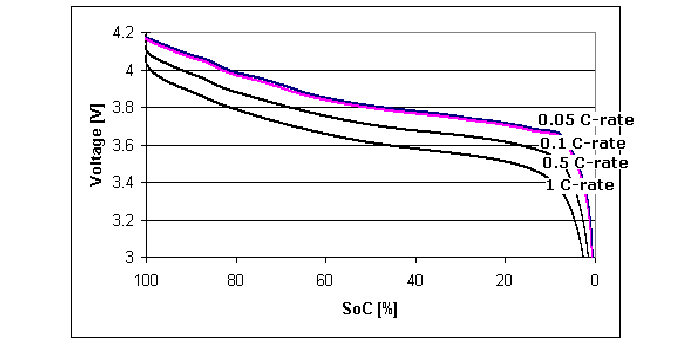
At 0.3C and higher rates we were using, we couldn’t find much of a correlation between speed of complete discharge and the degree to which measured capacity matched (or didn’t) rated capacity.
ABFOCE 10000mAh Waterproof Power Bank
Output: USB-A 10W
Input: Micro USB 10W
The ABFOCE 10000mAh Waterproof Power Bank is one of the inexpensive “survival” power banks from China that includes a compass and a light. We didn’t care much for either survival feature, and they seemed to add to the unit’s weight without adding a lot of value.
The performance of this charger was actually pretty good, as it stayed comfortably above 4.8V under a 2A load. It also ended up with a tiny bit more measured capacity than some of our top picks.
The size is also small, which we liked. But in general there’s definitely no reason to pick this over, say, the more feature-rich and lighter NOVOO at roughly the same price point.
Anker PowerCore 1000
Dedicated Output: USB-A, 2.4A max (12W)
Input: Micro-USB
The Anker PowerCore 1000 was the most compact and lightweight battery bank we tested. We love the form factor — it’s so small it’s pocketable — and the fact that the single USB-A gets up to 12W of output.
In our testing, we did see a sawtooth pattern in the voltage, an artifact that came up on more than one unit and is most likely the result of the bank trying to negotiate the optimal charging rate with our static load tester — all this means is that our load tester isn’t smart enough to tell the charger what it needs, it just constantly pulls the two amps we dialed into it.
To confirm that we could charge this with a compact solar panel, charged it for an hour with a small Renogy panel and measured how much current it pulled. It had no problems charging when connected to the panel, and the charging rate fluctuated with cloud cover and sunlight angle as expected.
Anker PowerCore II 20,000mAh
Outputs: USB-A 12W (2.4A) and 18W (3.6A)
Input: Micro-USB
There was some noise in the output of the Anker PowerCore II 20k — both voltage and current. We’re not quite sure what to make of it, but given that the voltage stayed comfortably above 5V and the current right at 2A, we’re not too concerned.
The round button on the top with the LED status lights is nice, and overall the build quality feels pretty average.
The main advantage of this unit is the power density — it gave us the second highest amp-hours per ounce rating (0.993) of any of the products we tested. So you can carry a lot of power for little weight with this.
We tested this unity by hooking it to a Renogy panel for about 45 minutes on a sunny day with intermittent cloud cover, and managed to put 633.6mAh into it, so we confirmed that it charges via solar just fine.
Anker PowerCore+ 26800
Outputs: Three USB-A at 5V/3A per port
Input: USB-C
We threw one really big pack into the mix, just as a point of reference for how much power our testing apparatus could get out of something larger. The Anker PowerCore+ 26800 is a nice, well-built unit in a metal housing, so at 21oz it’s well over our recommended weight limit of 12-16oz. But if you really need 45W of aggregate power output from a pack, then you’ll have to upgrade to something larger like this.
In our testing, the output was very stable and clean. Whatever quirks of the PowerIQ protocol that may have been causing the sawtooth waveform in the output from the smaller Anker unit was not in evidence, here.
Belkin Pocket Power 15K
Outputs: Two USB-A 17W
Input: Micro-USB 10W
The all-metal body of the Belkin Pocket Power 15K feels really premium, and we tend trust the Belkin name having used many of their products over the years. We couldn’t get a full 10W out of this pack in our testing, but it’s still possible that Belkin’s claim of a total 17W aggregate output between both ports is accurate.
The energy density of this unit is a bit low, and given that it weighs about the same as the higher-capacity Anker PowerCore II it’s hard to see why you’d pick it over the Anker.
FosPower PowerActive 10200 mAh Power Bank
Outputs: USB-A 10.5W
Input: Micro-USB
The FosPower PowerActive is a ruggedized power bank that just weighs a bit too much for what you get, thanks to the rubber grips and added compass. It does advertise an IP67 rating, and it did pass our dunk test.
The output from this unit wasn’t great — it really trailed off at the 2.5-hour mark in a way that the other packs did not. And it never really delivered a full 4.7V at two amps, despite being advertised as supporting 2.1A output.
Goal Zero Sherpa 40 Power Bank – discontinued
Outputs: Two USB-A 12W
Input: Micro-USB
As much as we love the GoalZero Sherpa 40’s ultra-slim form factor and tough metal body, this bank is just too heavy for the amount of charge it stores. The bank is rated at 12,000mAh, and we got 8,703mAh out of it, which is good. But it’s 13.4oz, which is heavier than even the 20,000mAh Anker PowerCore II.
We just can’t see paying $60 for a portable USB charger with a little over half the energy density of many far cheaper options. If the Sherpa were 30% or 40% lighter, we’d be all over it.
The Sherpa comes with two adapter cables that slot into the ends, and while they seem pretty firmly lodged in place we’d expect them to fall out when jostling around in a pack or bag.
HX160Y6/HX160Y7
Outputs: USB-A 10.5W and USB-A 5W
Input/Output: Micro USB 10.5W
The HX160X6 and HX160X7 are two Chinese-made units are identical except for some cosmetic considerations, like the finish and LED status lights. They also performed very well in our testing, giving us extremely clean power and voltage lines and a ton of stored charge. These ranked the highest in terms of amp-hours per ounce, and they’re also the cheapest in amp-hours per dollar by a wide margin.
These units are typically advertised as 26,800mAh, but they’re clearly 20,000mAh packs in our testing (and also judging by size and weight).
So if you want to take a gamble on some random Chinese chargers that are sold under a ton of different labels on Amazon, and that you may not get any kind of support for if they stop working, then these are the best deal we’ve found right now.
Jackery Bolt 10050mAh Power Bank
Outputs: USB-A 12W
Input: Micro-USB
The Jackery Bolt 10050 is a slightly more compact version of the Giant+. It has one less port than its larger sibling, but the build quality is equally good. The Bolt did very well in our load testing, and we have no complaints about the output.
We love the two built-in adapters on the side — one lets you plug the Bolt directly into an iPhone, and the other into a Micro USB device. These thick, rubberized adapters feel like they could stand up to quite a bit of use and abuse, and overall this is a clever add-on feature that we like a lot. It’s very nice for EDC purposes, and even for survival purposes it reduces the number of adapters you have to wrangle.
Jackery Portable Charger Giant+ 12000mAh Power Bank
Outputs: Two USB-A 12W
Input: Micro-USB
Both the Jackery banks we tested have solid metal housings that feel like they could take a beating, but this causes their storage to weight ratio to suffer. Still, we got a very respectable 7,156mAh out of the Jackery Giant+, which is a little over 1,000mAh more than its lower-capacity peers.
There’s a small LED light on the unit, but it’s so tiny and dim it won’t do for much more than finding your keys in the dark.
Our impression of the Giant+ was positive — this is a good, compact charger that performed well, and it’s something we’d consider for EDC. But it didn’t stand out enough to be a final pick.
Luxtude 20000mAh Waterproof Portable Charger
Outputs: Two USB-A 12W
Inputs: Micro-USB 18W, USB-C 18W
The Luxtude 20000mAh Waterproof Portable Charger has essentially the same tech specs and features as the Techsmarter, with the important difference that its Micro-USB and USB-C ports are input only (the Techsmarter’s go both ways).
In terms of form factor, the metal and rubber body feels sturdier while saving a little over half an ounce on weight vs. the Techsmarter. There’s a comparable light, and there’s also a fabric loop that can be used to hang the pack. The pack will also stand one end, which helps with its use as a light.
The main problem with the Luxtude is that the output voltage wasn’t high enough with a 2A load — it just didn’t make it over 4.6V, so we didn’t get quite the level of power output from it that we got out of the Techsmarter.
Overall, though, we liked this charger, and given that at $46 it’s $20 cheaper than the Techsmarter it would be a strong contender for a hypothetical “Best Ruggedized 20,000mAh” pick.
NOVOO Portable 10000mAh Battery Pack Quick Charge 18W Power Bank
Outputs: USB-A 5V/1.5A
Input/Output: USB-C 5V/3.6
The 8oz NOVOO Explorer is shockingly light for how sturdy it is, and it passed our dunk test so the IP67 rating is legit. The small LED light that’s included works pretty well, and the rubber loop on one corner is a nice touch.
Even though the USB-A port is advertised as 1.5A, we did get 2A out of it in our load test. However, the voltage suffered because of the higher load, coming in just over 4.6. If we dial down the load, though, the voltage goes up closer to 5V.
Overall, the NOVOO’s combination of outdoors-friendly features, low weight, and capacity, earned it a spot in our picks (and in our packs).
OUTXE USB C Solar Powered Phone Charger 10000mAh
Outputs: USB-A 15W
Inputs/Outputs: USB-C 15W, Micro-USB 10W
With one of the lowest energy density ratings in our review, the OUTXE USB C Solar Powered Phone Charger 10000mAh is a good example of the price of ruggedization and extra features. We do like the added solar panel as a last-ditch charging option, and the on-board light is bright enough to be usable. But the end result is power bank that’s as bulky some of the 20,000mAh units. In fact, it’s surprisingly close in volume to the Techsmarter.
The OUTXE did have some technical problems, as well. The USB-A output is supposed to support loads up to three amps, but there’s no way that’s possible — when pulling just 2A from it we could never get the voltage above 4.6V. So it doesn’t quite deliver on what’s advertised.
Techsmarter 20000mah Rugged & Waterproof Power Bank IP66 18W
Outputs: USB-A 18W, USB-A 12W
Input/Output: 18W USB-C, 15W Micro-USB
If we were going to recommend a “Best Ruggedized 20,000mAh”, the Techsmarter 20000mah 18W Power Delivery Power Bank would probably be it. The bank’s performance in our testing was excellent: the current was very stable at 2A, and despite this weird jump in the beginning from 4.7V to to 4.8, the voltage was stable, as well.
This unit has an excellent array of ports — you’d never need to worry about adapters, which is a real advantage given how fragile adapters are. The ports are covered by a rubber cover, hence the unit’s IP66 water resistance rating.
There’s a very bright LED light on one side of the charger, with two modes: always-on, and flashing SOS. When you pair that with the Techsmarter’s ability to stand on one end or be hung from a small metal loop in the bottom, there’s a lot of flexibility for using this as a lamp or work light.
When prepping for a possible on-foot bugout, we’d much rather save a few ounces and not have the extra “survival” stuff. But if you want something to carry on a car trip, or if you’ve got pack space to spare, then this is a very solid “survival” upgrade over our main 20,000mAh pick.
This unit has two downsides: low energy density, and high price. You pay in weight for the ruggedization and extra features, but for prepping purposes we’re just not convinced it’s worth it. And you pay in dollars for the unit as a whole — this is the most expensive charger of this size we tested.
Unifun 10400mAh Waterproof External Battery Power Bank
Outputs: USB-A 5V/1.0A and USB-A 5V/2.1A.
Input: micro-USB 5V/2A
The Unifun 10k is a ruggedized pack that really didn’t do great in our testing, and when you combine it with the unit’s 11oz weight it’s hard to recommend. The build quality feels solid, and but the light’s a little anemic. The best thing we can say about it was that the voltage and current output were very steady.
